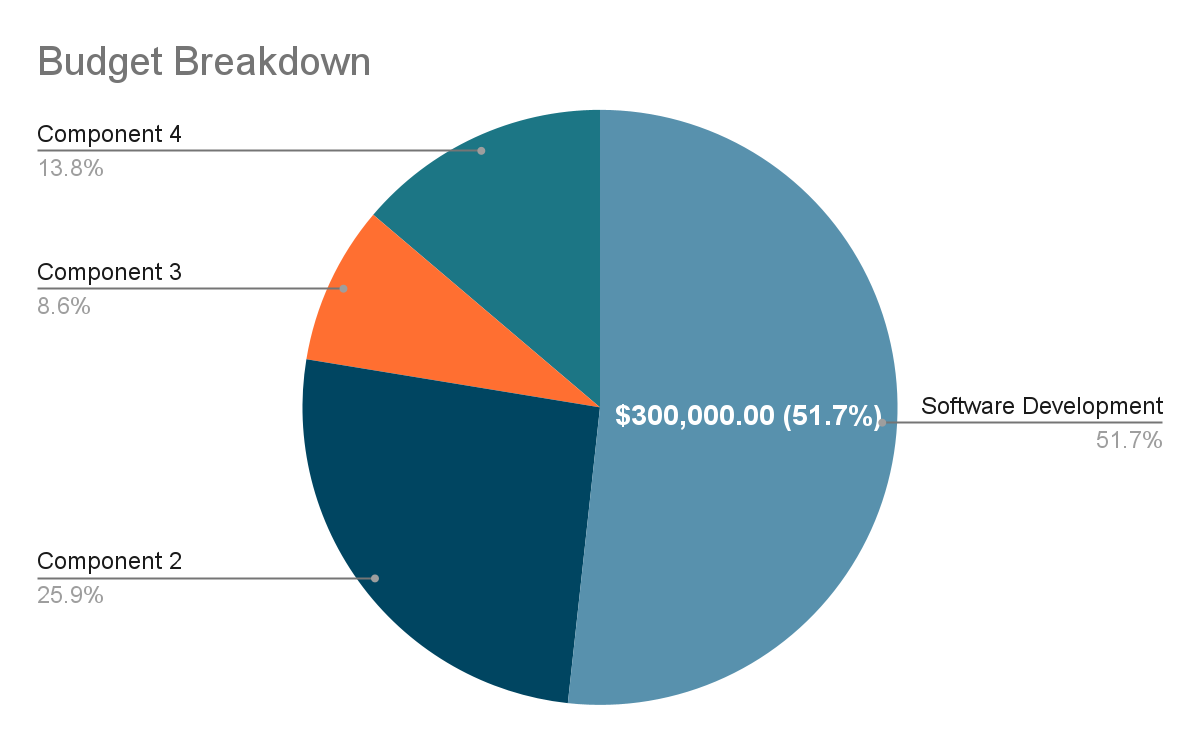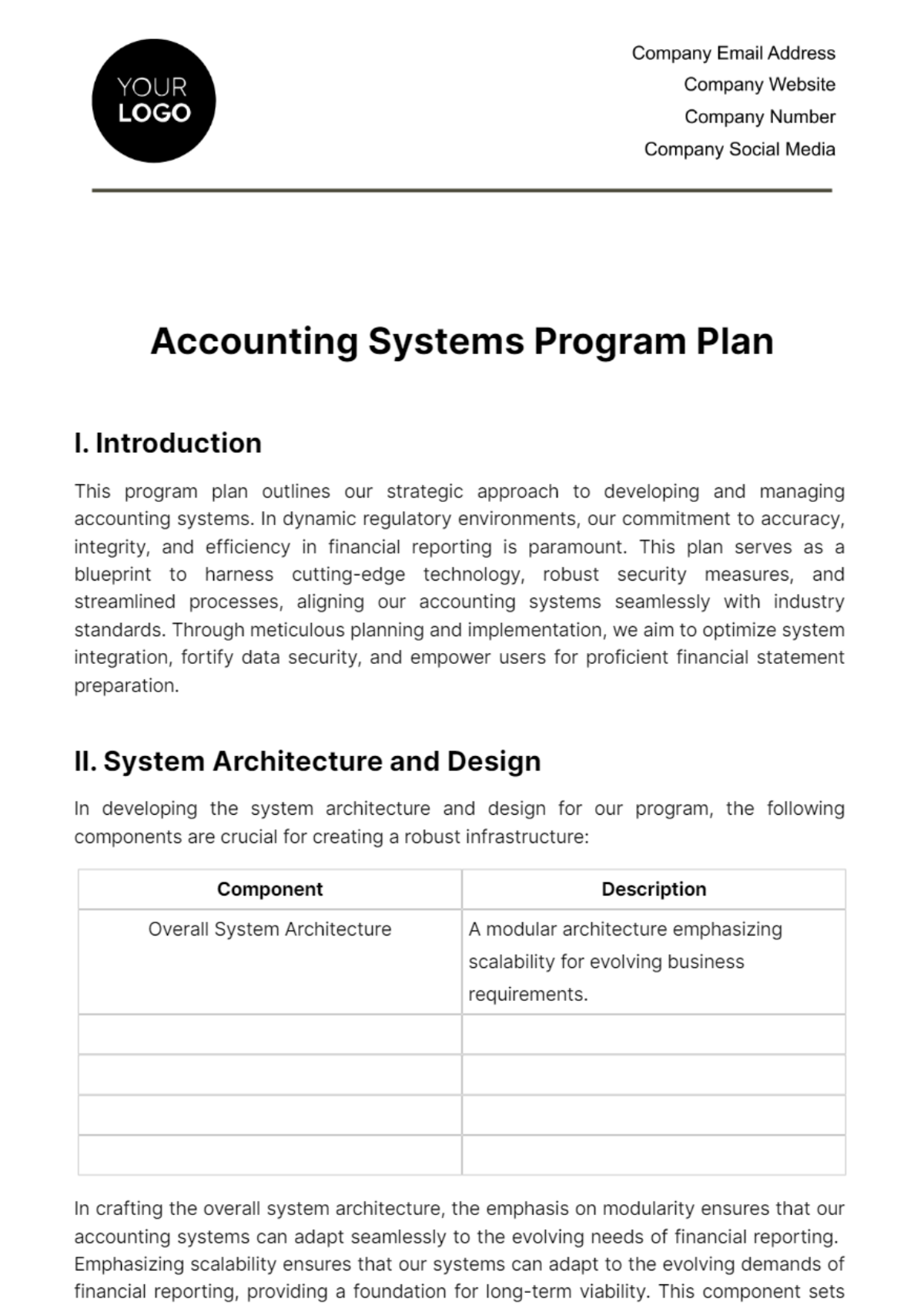Accounting Systems Program Plan
I. Introduction
This program plan outlines our strategic approach to developing and managing accounting systems. In dynamic regulatory environments, our commitment to accuracy, integrity, and efficiency in financial reporting is paramount. This plan serves as a blueprint to harness cutting-edge technology, robust security measures, and streamlined processes, aligning our accounting systems seamlessly with industry standards. Through meticulous planning and implementation, we aim to optimize system integration, fortify data security, and empower users for proficient financial statement preparation.
II. System Architecture and Design
In developing the system architecture and design for our program, the following components are crucial for creating a robust infrastructure:
Component | Description |
Overall System Architecture | A modular architecture emphasizing scalability for evolving business requirements. |
| |
| |
| |
| |
In crafting the overall system architecture, the emphasis on modularity ensures that our accounting systems can adapt seamlessly to the evolving needs of financial reporting. Emphasizing scalability ensures that our systems can adapt to the evolving demands of financial reporting, providing a foundation for long-term viability. This component sets the tone for an agile and resilient system architecture, aligning with our commitment to efficiency and adaptability in the dynamic landscape of accounting processes. All in all these components collectively establish the framework for an agile, user-friendly, and secure accounting infrastructure.
III. Integration with Financial Processes
In optimizing the integration between our accounting systems and financial processes, strategic considerations play a pivotal role. The table below outlines key components aimed at ensuring seamless data flow and alignment:
Component | Description |
Financial Process Identification | Identification of key financial processes, including accounts payable and receivable. |
| |
| |
| |
| |
A well-integrated system not only supports current financial workflows but also positions the organization for adaptability to future process enhancements and technological advancements. The financial process identification is foundational for optimizing the integration of our accounting systems with essential financial processes. Identifying key processes, such as accounts payable and receivable, ensures that the systems are tailored to the specific requirements of these critical financial functions. This involves mapping out the workflow of each process, understanding data dependencies, and identifying potential points of integration. By pinpointing these processes, we create a roadmap for the seamless exchange of financial data, minimizing redundancies, and enhancing accuracy in financial statement preparation.
IV. Budget
In ensuring the successful execution of our program, a well-structured budget is crucial. The table below provides a breakdown of financial allocations for facilitating transparent resource management and alignment:

The overall budget components are strategically structured to ensure the successful execution of our program. Each allocated segment serves a distinct purpose, covering critical aspects. The allocation for Software Development in the budget is integral for creating a bespoke accounting system tailored to the specific needs of our program. This financial provision encompasses the entire software development life cycle, starting from the initial design and programming stages to the final implementation and testing phases. The estimated cost of $300,000 accounts for acquiring skilled developers, software licenses, and any associated tools necessary for coding and system integration. It ensures the development of a sophisticated and user-friendly system that aligns seamlessly with the intricacies of financial statement preparation. This investment underscores a commitment to technological excellence, fostering a system that not only meets current requirements but is also adaptable to future advancements in accounting processes and industry standards.
V. Implementation Timeline and Milestones
A well-structured implementation timeline is paramount for the successful rollout of our program. The table below delineates key milestones, ensuring a phased and organized approach to system deployment:
Milestone | Start Date | End Date |
Project Initiation | 01/01/2050 | 01/15/2050 |
| | |
| | |
| | |
| | |
The first milestone, Project Initiation, will be a pivotal phase marking the commencement of our program. During this period, the project team will be assembled, comprising key stakeholders, project managers, and technical experts. This milestone will set the foundation for a well-coordinated and collaborative approach to the subsequent phases of the implementation. By establishing clear milestones, the plan ensures systematic progress monitoring and effective management of each implementation stage. The timeline serves as a roadmap for the project team, fostering collaboration and coordination. It enables stakeholders to track progress, manage expectations, and identify potential bottlenecks or delays.
Accounting Templates @ Template.net






























